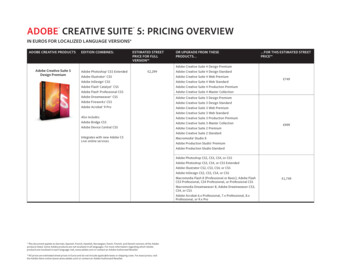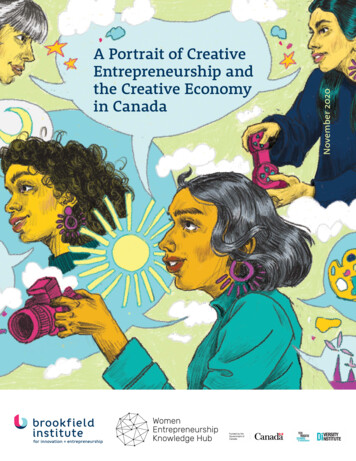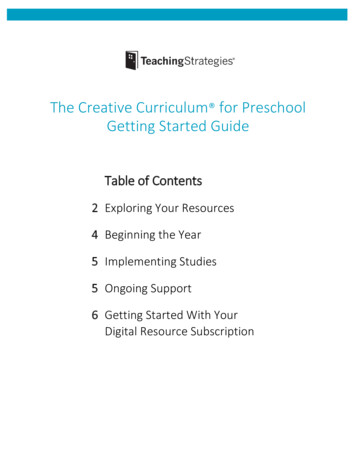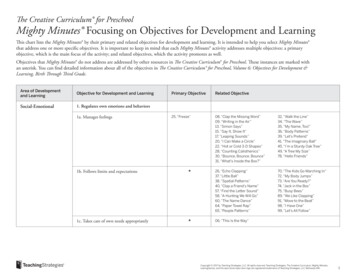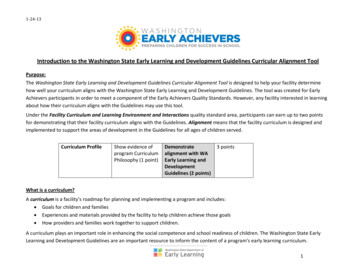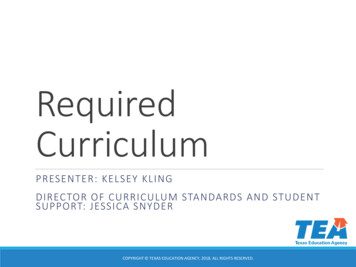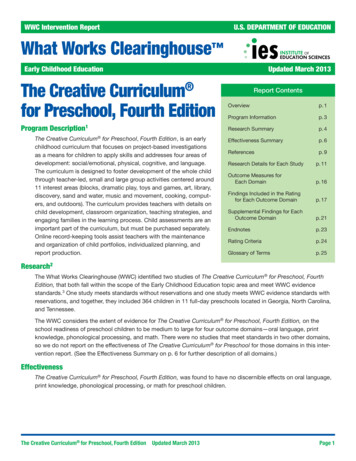
Transcription
WWC Intervention ReportU.S. DEPARTMENT OF EDUCATIONWhat Works Clearinghouse Early Childhood EducationUpdated March 2013The Creative Curriculum for Preschool, Fourth EditionProgram Description1 The Creative Curriculum for Preschool, Fourth Edition, is an earlychildhood curriculum that focuses on project-based investigationsas a means for children to apply skills and addresses four areas ofdevelopment: social/emotional, physical, cognitive, and language.The curriculum is designed to foster development of the whole childthrough teacher-led, small and large group activities centered around11 interest areas (blocks, dramatic play, toys and games, art, library,discovery, sand and water, music and movement, cooking, computers, and outdoors). The curriculum provides teachers with details onchild development, classroom organization, teaching strategies, andengaging families in the learning process. Child assessments are animportant part of the curriculum, but must be purchased separately.Online record-keeping tools assist teachers with the maintenanceand organization of child portfolios, individualized planning, andreport production.Report ContentsOverviewp. 1Program Informationp. 3Research Summaryp. 4Effectiveness Summaryp. 6Referencesp. 9Research Details for Each Studyp. 11Outcome Measures forEach Domainp. 16Findings Included in the Ratingfor Each Outcome Domainp. 17Supplemental Findings for EachOutcome Domainp. 21Endnotesp. 23Rating Criteriap. 24Glossary of Termsp. 25Research2The What Works Clearinghouse (WWC) identified two studies of The Creative Curriculum for Preschool, FourthEdition, that both fall within the scope of the Early Childhood Education topic area and meet WWC evidencestandards.3 One study meets standards without reservations and one study meets WWC evidence standards withreservations, and together, they included 364 children in 11 full-day preschools located in Georgia, North Carolina,and Tennessee.The WWC considers the extent of evidence for The Creative Curriculum for Preschool, Fourth Edition, on theschool readiness of preschool children to be medium to large for four outcome domains—oral language, printknowledge, phonological processing, and math. There were no studies that meet standards in two other domains,so we do not report on the effectiveness of The Creative Curriculum for Preschool for those domains in this intervention report. (See the Effectiveness Summary on p. 6 for further description of all domains.)EffectivenessThe Creative Curriculum for Preschool, Fourth Edition, was found to have no discernible effects on oral language,print knowledge, phonological processing, or math for preschool children.The Creative Curriculum for Preschool, Fourth EditionUpdated March 2013Page 1
WWC Intervention ReportTable 1. Summary of findings4Improvement index (percentile points)Rating of effectivenessAverageRangeNumber ofstudiesNumber ofchildrenExtent ofevidenceOral languageNo discernible effects 2–6 to 92362Medium to largePrint knowledgeNo discernible effects–2–7 to 82363Medium to largePhonological processingNo discernible effects–2–4 to 12364Medium to largeMathNo discernible effects 2–5 to 82363Medium to largeOutcome domainThe Creative Curriculum for Preschool, Fourth EditionUpdated March 2013Page 2
WWC Intervention ReportProgram InformationBackgroundDeveloped by Diane Trister Dodge, Laura Colker, and Cate Heroman, The Creative Curriculum for Preschool,Fourth Edition, is distributed by Teaching Strategies, Inc. Address: 7101 Wisconsin Ave., Suite 700, Bethesda, MD20814. Email: CustomerRelations@TeachingStrategies.com. Web: http://www.teachingstrategies.com/. Telephone:(800) 637-3652.The studies reviewed by the WWC are all evaluations of the Fourth Edition of The Creative Curriculum forPreschool. In July 2011, the developer released The Creative Curriculum for Preschool, Fifth Edition, as part ofThe Creative Curriculum System for Preschool. No effectiveness studies of this updated, expanded curriculumhave been completed. Therefore, this intervention report focuses on the Fourth Edition.Program detailsThe Creative Curriculum for Preschool, Fourth Edition, is an early childhood curriculum designed to foster social/emotional, physical, cognitive, and language development and to enhance learning in literacy, math, science,social studies, the arts, and technology. The program includes information on children’s development and learning,classroom organization and structure, teaching strategies, instructional goals and objectives, and guidance on howto engage families in their children’s learning. The Creative Curriculum for Preschool provides direction for intentional, teacher-guided learning experiences in large and small group settings.The program is centered around the following 11 interest areas: blocks, dramatic play, toys and games, art, library,discovery, sand and water, music and movement, cooking, computers, and outdoors. The curriculum describesthe learning that occurs through play in each area, the ways in which children might engage with the materials ineach area, and teacher interactions to promote and scaffold children’s learning. The curriculum includes the useof project-based investigations, called “studies,” that are focused on meaningful science and social studies topicsand that aim to provide children with an opportunity to apply skills in literacy, math, the arts, and technology. Suggestions on how to adapt these activities for children with disabilities and English language learners are providedfor each component of the curriculum.The Creative Curriculum for Preschool also emphasizes the use of observation-based child assessments to helpguide instruction. In addition to the general curriculum guide, separate literacy, math, science, and social studiesguides are available. Implementation, evaluation guidance, and professional development services are also available from the developer, both online and onsite.CostThe Creative Curriculum for Preschool, Fourth Edition, is no longer available for purchase from the distributor.The Creative Curriculum : The Foundation, a teacher’s guide to The Creative Curriculum for Preschool, Fifth Edition,can be purchased for 189.95. This guide provides the theory and research foundation of the curriculum and helpsteachers decide how to set up their classrooms. Teaching Strategies, Inc., also offers The Creative Curriculum Systemfor Preschool, which provides all the resources necessary to implement the program in a classroom. The system costs 2,149.00 and includes the following curriculum materials: The Creative Curriculum : The Foundation, The Guide toThe Creative Curriculum System for Preschool, Getting Started DVD, 100 Mighty MinutesTM activity cards, 201 BilingualIntentional Teaching CardsTM, six teaching guides, 22 book discussion cards, The Teaching Strategies Children’s BookCollection featuring 75 books, The Resource Organizer, and The Classroom and Family Resources CD-ROM.Additional implementation and evaluation guidance, as well as professional development services, can be purchased from the developer and delivered either onsite or online.The Creative Curriculum for Preschool, Fourth EditionUpdated March 2013Page 3
WWC Intervention ReportResearch SummaryThe WWC identified 14 studies that investigated the effects of TheCreative Curriculum for Preschool, Fourth Edition, on the schoolreadiness of preschool children.Table 2. Scope of reviewed researchGradePKDelivery methodWhole classThe WWC reviewed four of those studies against group designProgram typeCurriculumevidence standards. One study (PCER Consortium, 2008, Chapter 3)is a randomized controlled trial that meets WWC evidence standardswithout reservations and one study (PCER Consortium, 2008, Chapter 2) is a randomized controlled trial thatmeets WWC evidence standards with reservations. Those two studies are summarized in this report. Two studies do not meet WWC evidence standards. The remaining ten studies do not meet WWC eligibility screens forreview in this topic area. Citations for all 14 studies are in the References section, which begins on p. 9.Summary of study meeting WWC evidence standards without reservationsThe PCER Consortium (2008) study (Chapter 3) assessed the effects of The Creative Curriculum for Preschoolusing a randomized controlled trial of teachers and children in five Head Start centers in Georgia and North Carolina.5 In the pilot year of the study (the 2002–03 school year), 20 teachers were grouped by education and teachercertification status and then randomly assigned within each group to either the intervention group or the comparison group. Eighteen of the classrooms that were randomly assigned in the pilot year continued to participate duringthe national PCER evaluation year (the 2003–04 school year), and 194 children were selected for the study. Childrenwithin a Head Start center were sorted into groups on the basis of gender, disability status, and ethnicity, and withingroups, they were randomly assigned to either intervention or comparison classrooms. Each of the five participating Head Start centers included both intervention and comparison classrooms.The authors investigated effects on oral language, print knowledge, phonological processing, and math. The WWCbased its effectiveness ratings on findings from comparisons of 90 children who received The Creative Curriculum for Preschool and 81 comparison group children. The comparison condition was not a particular curriculum;rather, it consisted of teacher-developed curricula with a focus on basic school readiness. The authors reported onthe effects of The Creative Curriculum for Preschool in the spring of the preschool year and again at the end ofkindergarten. The outcomes reported at the end of the kindergarten year are not included in the WWC’s effectiveness calculations but are presented as supplemental findings in Appendix D. The authors also reported findings onthe Social Skills Rating Scale; however, these findings are not reported here because the current Early ChildhoodEducation topic area protocol does not include sociobehavioral outcomes.Summary of study meeting WWC evidence standards with reservationsThe PCER Consortium (2008) study (Chapter 2) assessed the effects of The Creative Curriculum for Preschoolusing a randomized controlled trial of classrooms in 28 preschools in Tennessee. In the pilot year of the study (the2002–03 school year), 36 full-day preschool classrooms were sorted into groups of three on the basis of demographic and achievement characteristics and then, within each group of three, randomly assigned to one of twointervention groups, The Creative Curriculum for Preschool or Bright Beginnings, or to a comparison group. At thetime of random assignment, 21 of the 36 classrooms (seven from each group) were randomly selected to becomepart of the national PCER evaluation study (during the 2003–04 school year). Eight of the 21 classrooms selected forthe national PCER evaluation year dropped out at the end of the pilot year, but were replaced with eight classroomsrandomly selected from the original 36 classrooms, bringing the total back to seven classrooms per group in thenational PCER evaluation study in 2003–04 (seven The Creative Curriculum for Preschool and seven comparison).The Creative Curriculum for Preschool, Fourth EditionUpdated March 2013Page 4
WWC Intervention ReportAlthough the PCER Consortium (2008) study (Chapter 2) used a randomized controlled trial design to assign classrooms to intervention or comparison conditions in the pilot study year, the study (Chapter 2) analyzed data from thenational PCER evaluation year (2003–04 school year), when children who had been in the classrooms at the timeof random assignment (the start of the 2002–03 school year) had moved on to kindergarten, and a new class ofchildren had replaced them. Thus, the study has high attrition at the child level and, under WWC standards, mustdemonstrate baseline equivalence between the intervention and comparison group sample of children used in theanalyses of outcomes.The authors investigated effects on oral language, print knowledge, phonological processing, and math. The WWCbased its effectiveness ratings on findings from comparisons of 93 children who received The Creative Curriculum for Preschool and 100 comparison group children. The comparison condition was not a particular curriculum; rather,it consisted of teacher-developed curricula with a focus on basic school readiness. Fifty-one percent of the childrenwere male, 82% were Caucasian, and 23% were reported to have a disability. The study demonstrated the baselineequivalence of the outcome measures in the oral language, print knowledge, phonological processing, and mathdomains for the analytic samples of intervention and comparison group children at the end of the preschool year.6The authors reported on the effects of The Creative Curriculum for Preschool in the spring of the preschool year andagain at the end of kindergarten. The kindergarten findings are not reported here because information about the baseline equivalence of the outcome measures for the kindergarten sample was not provided in the report. The authorsalso reported findings on the Social Skills Rating Scale; however, these findings are not reported here because thecurrent Early Childhood Education topic area protocol does not include sociobehavioral outcomes.The Creative Curriculum for Preschool, Fourth EditionUpdated March 2013Page 5
WWC Intervention ReportEffectiveness SummaryThe WWC review of The Creative Curriculum for Preschool, Fourth Edition, for the Early Childhood Education topicarea includes child outcomes in six domains: oral language, print knowledge, phonological processing, early readingand writing, cognition, and math. The two studies of The Creative Curriculum for Preschool that meet WWC evidencestandards reported findings in four of the six domains: (a) oral language, (b) print knowledge, (c) phonological processing, and (d) math. The findings below present the authors’ estimates and WWC-calculated estimates of the sizeand statistical significance of the effects of The Creative Curriculum for Preschool on preschool children. For a moredetailed description of the rating of effectiveness and extent of evidence criteria, see the WWC Rating Criteria on p. 24.Summary of effectiveness for the oral language domainOne study that meets WWC evidence standards without reservations and one study that meets WWC evidencestandards with reservations reported findings in the oral language domain.The PCER Consortium (2008, Chapter 3) analyzed the effectiveness of The Creative Curriculum for Preschool onoral language outcomes using the Peabody Picture Vocabulary Test III (PPVT-III) and the Test of Language Development–Primary III (TOLD-P:3) Grammatic Understanding subtest. The authors report, and the WWC confirms, thatdifferences between The Creative Curriculum for Preschool group and the comparison group are not statisticallysignificant or substantively important (that is, an effect size of at least 0.25) on either of these measures. The WWCcharacterizes these study findings as an indeterminate effect.The PCER Consortium (2008, Chapter 2) examined the effectiveness of The Creative Curriculum for Preschool onoral language using the PPVT-III and the TOLD-P:3. The authors report, and the WWC confirms, that differencesbetween The Creative Curriculum for Preschool group and the comparison group are not statistically significant orsubstantively important on either of these measures. The WWC characterizes these study findings as an indeterminate effect.Thus, for the oral language domain, both studies found indeterminate effects. This results in a rating of no discernible effects, with a medium to large extent of evidence.Table 3. Rating of effectiveness and extent of evidence for the oral language domainRating of effectivenessCriteria metNo discernible effectsNo affirmative evidence of effects.In the two studies that reported findings, the estimated impact of the intervention on outcomes in the orallanguage domain was neither statistically significant nor large enough to be substantively important.Extent of evidenceCriteria metMedium to largeTwo studies that included 362 children in 32 classrooms reported evidence of effectiveness in the oral languagedomain.Summary of effectiveness for the print knowledge domainOne study that meets WWC evidence standards without reservations and one study that meets WWC evidencestandards with reservations reported findings in the print knowledge domain.The PCER Consortium (2008, Chapter 3) analyzed the effectiveness of The Creative Curriculum for Preschool onthe Test of Early Reading Ability III (TERA-3), the Woodcock-Johnson III (WJ-III) Letter-Word Identification subtest,and the WJ-III Spelling subtest. The authors report, and the WWC confirms, that differences between The CreativeCurriculum for Preschool and comparison groups are not statistically significant or large enough to be substantively important on any of these measures. The WWC characterizes these study findings as an indeterminate effect.The Creative Curriculum for Preschool, Fourth EditionUpdated March 2013Page 6
WWC Intervention ReportThe PCER Consortium (2008, Chapter 2) examined the effectiveness of The Creative Curriculum for Preschool onthe TERA-3, the WJ-III Letter-Word Identification subtest, and the WJ-III Spelling subtest. The authors report, andthe WWC confirms, that differences between The Creative Curriculum for Preschool and comparison groups arenot statistically significant or large enough to be substantively important on any of these measures. The WWC characterizes these study findings as an indeterminate effect.Thus, for the print knowledge domain, both studies found indeterminate effects. This results in a rating of no discernible effects, with a medium to large extent of evidence.Table 4. Rating of effectiveness and extent of evidence for the print knowledge domainRating of effectivenessCriteria metNo discernible effectsNo affirmative evidence ofeffects.In the two studies that reported findings, the estimated impact of the intervention on outcomes in the printknowledge domain was neither statistically significant nor large enough to be substantively important.Extent of evidenceCriteria metMedium to largeTwo studies that included 363 children in 32 classrooms reported evidence of effectiveness in the printknowledge domain.Summary of effectiveness for the phonological processing domainOne study that meets WWC evidence standards without reservations and one study that meets WWC evidencestandards with reservations reported findings in the phonological processing domain.The PCER Consortium (2008, Chapter 3) analyzed the effectiveness of The Creative Curriculum for Preschoolon phonological processing using the Preschool Comprehensive Test of Phonological and Print Processing (PreCTOPPP) Elision subtest. The authors report, and the WWC confirms, that differences between The CreativeCurriculum for Preschool and comparison groups are not statistically significant or substantively important onthis measure. The WWC characterizes these study findings as an indeterminate effect.The PCER Consortium (2008, Chapter 2) also analyzed the effectiveness of The Creative Curriculum for Preschoolon phonological processing using the Pre-CTOPPP Elision subtest. The authors report, and the WWC confirms, thatdifferences between The Creative Curriculum for Preschool and comparison groups are not statistically significant orsubstantively important on this measure. The WWC characterizes these study findings as an indeterminate effect.Thus, for the phonological processing domain, both studies found indeterminate effects. This results in a rating ofno discernible effects, with a medium to large extent of evidence.Table 5. Rating of effectiveness and extent of evidence for the phonological processing domainRating of effectivenessCriteria metNo discernible effectsNo affirmative evidence ofeffects.In the two studies that reported findings, the estimated impact of the intervention on outcomes in the phonologicalprocessing domain was neither statistically significant nor large enough to be substantively important.Extent of evidenceCriteria metMedium to largeTwo studies that included 364 children in 32 classrooms reported evidence of effectiveness in the phonologicalprocessing domain.Summary of effectiveness for the math domainOne study that meets WWC evidence standards without reservations and one study that meets WWC evidencestandards with reservations reported findings in the math domain.The Creative Curriculum for Preschool, Fourth EditionUpdated March 2013Page 7
WWC Intervention ReportThe PCER Consortium (2008, Chapter 3) analyzed the effectiveness of The Creative Curriculum for Preschool onmath using the WJ-III Applied Problems subtest, the Child Math Assessment–Abbreviated (CMA-A), and the Building Blocks Shape Composition task. The authors report, and the WWC confirms, that differences between TheCreative Curriculum for Preschool and comparison groups are not statistically significant or large enough to besubstantively important on any of these measures. The WWC characterizes these study findings as an indeterminate effect.The PCER Consortium (2008, Chapter 2) also examined the effectiveness of The Creative Curriculum for Preschoolon math using the WJ-III Applied Problems subtest, the CMA-A, and the Building Blocks Shape Composition task.The authors report, and the WWC confirms, that differences between The Creative Curriculum for Preschool andcomparison groups are not statistically significant or large enough to be substantively important on any of thesemeasures. The WWC characterizes these study findings as an indeterminate effect.Thus, for the math domain, both studies found indeterminate effects. This results in a rating of no discernibleeffects, with a medium to large extent of evidence.Table 6. Rating of effectiveness and extent of evidence for the math domainRating of effectivenessCriteria metNo discernible effectsNo affirmative evidence ofeffects.In the two studies that reported findings, the estimated impact of the intervention on outcomes in the mathdomain was neither statistically significant nor large enough to be substantively important.Extent of evidenceCriteria metMedium to largeTwo studies that included 363 children in 32 classrooms reported evidence of effectiveness in the math domain.The Creative Curriculum for Preschool, Fourth EditionUpdated March 2013Page 8
WWC Intervention ReportReferencesStudy that meets WWC evidence standards without reservationsPreschool Curriculum Evaluation Research (PCER) Consortium. (2008, chapter 3). Creative Curriculum: Universityof North Carolina at Charlotte. In Effects of preschool curriculum programs on school readiness (pp. 55–64,Appendix C, and Appendix D). Washington, DC: National Center for Education Research, Institute of Education Sciences, U.S. Department of Education.Study that meets WWC evidence standards with reservationsPreschool Curriculum Evaluation Research (PCER) Consortium. (2008, chapter 2). Bright Beginnings and CreativeCurriculum: Vanderbilt University. In Effects of preschool curriculum programs on school readiness (pp. 41–54,Appendix C, and Appendix D). Washington, DC: National Center for Education Research, Institute of Education Sciences, U.S. Department of Education.Studies that do not meet WWC evidence standardsHartford Foundation for Public Giving. (2004). Hartford children are learning by leaps and bounds: Achievements ofchildren involved in Brighter Futures Child Care Enhancement Project. Hartford, CT: Author. The study doesnot meet WWC evidence standards because the measures of effectiveness cannot be attributed solely to theintervention—the intervention was combined with another intervention.Henry, G. T., Ponder, B. D., Rickman, D. K., Mashburn, A. J., Henderson, L. W., & Gordon, C. S. (2004). An evaluation of the implementation of Georgia’s pre-K program: Report of the findings from the Georgia early childhood study (2002-03). Atlanta: Georgia State University, Andrew Young School of Policy Studies. The studydoes not meet WWC evidence standards because it uses a quasi-experimental design in which the analyticintervention and comparison groups are not shown to be equivalent.Additional source:Henry, G. T., Henderson, L. W., Ponder, B. D., Gordon, C. S., Mashburn, A. J., & Rickman, D. K. (2003). Reportof the findings from the early childhood study: 2001–2001. Atlanta: Georgia State University, AndrewYoung School of Policy Studies.Studies that are ineligible for review using the Early Childhood Education Evidence Review ProtocolAbbott-Shim, M. (2000). Sure Start effectiveness study: Final report. Atlanta, GA: Report for the U.S. Department ofDefense Education Activity by Quality Assist, Inc. The study is ineligible for review because it does not use acomparison group design or a single-case design.Additional source:Zigler, E. F., & Bishop-Josef, S. J. (2006). The cognitive child versus the whole child: Lessons from 40 years ofHead Start. In D. G. Singer, R. M. Golinkoff, & K. Hirsh-Pasek (Eds.), Play learning: How play motivatesand enhances children’s cognitive and social-emotional growth (pp. 15–35). New York: Oxford UniversityPress.Cabell, S. Q., Justice, L. M., Konold, T. R., & McGinty, A. S. (2011). Profiles of emergent literacy skills among preschool children who are at risk for academic difficulties. Early Childhood Research Quarterly, 26(1), 1–14. Thestudy is ineligible for review because it does not implement the intervention in a way that falls within the scopeof the review—the intervention is bundled with other components.Chambers, B., Cheung, A., Slavin, R. E., Smith, D., & Laurenzano, M. (2010). Effective early childhood educationprograms: A systematic review. Baltimore, MD: Johns Hopkins University, Center for Research and Reform inEducation. Retrieved from http://www.bestevidence.org/word/early child ed Sep 22 2010.pdf The study isineligible for review because it is a secondary analysis of the effectiveness of an intervention, such as a metaanalysis or research literature review.The Creative Curriculum for Preschool, Fourth EditionUpdated March 2013Page 9
WWC Intervention ReportCordell, M. (2010). The impact of technical coaching in emergent literacy and language curriculum on a HeadStart teacher, staff members, English language learners, and Hispanic family literacy practices. DissertationAbstracts International Section: A. Humanities and Social Sciences, 71(4-A), 1180. The study is ineligible forreview because it does not use a comparison group design or a single-case design.Dodge, D. T., Bickart, T. S., Heroman, C., & Boyle, K. (2009). Teaching Strategies’ Creative Curriculum for preschool: Opening doors for teachers, children, and families. Early Childhood Services: An InterdisciplinaryJournal of Effectiveness, 3(3), 263–280. The study is ineligible for review because it is a secondary analysis ofthe effectiveness of an intervention, such as a meta-analysis or research literature review.File, N., Mueller, J. J., & Wisneski, D. B. (2011). Curriculum in early childhood education: Re-examined, rediscovered, renewed. Florence, KY: Routledge, Taylor & Francis Group. The study is ineligible for review because itis a secondary analysis of the effectiveness of an intervention, such as a meta-analysis or research literaturereview.Florida Center for Reading Research. (2005). Literacy: The Creative Curriculum approach. Tallahassee, FL: Author.Retrieved from rriculum.pdf The study is ineligible forreview because it is a secondary analysis of the effectiveness of an intervention, such as a meta-analysis orresearch literature review.Gomby, D., Spiker, D., Golan, S., Zercher, C., Daniels, M., & Quirk, K. (2005). Los Angeles County Vaughn NextCentury Learning Center. Supporting literacy: Curriculum, technology, parents, and experts. In Case studies of the First 5 School Readiness Initiative. Promising programs and practices: A focus on early literacy (pp.2-73–2-87). Santa Monica, CA: SRI International. The study is ineligible for review because it does not use acomparison group design or a single-case design.Kuamoo, M. (2008). An evaluation of quality in early education: The role of curriculum and teacher–child outcomes(Unpublished doctoral dissertation). Capella University, Minneapolis, MN. The study is ineligible for reviewbecause it does not use a comparison group design or a single-case design.Lambert, R. G., Abott-Shim, M., & Kusherman, J. (2006). The effect of Creative Curriculum training and technicalassistance on Head Start classroom quality. Paper presented at the annual meetings of the North CarolinaAssociation for Research in Education, March 30, Hickory, NC and the American Educational Research Association, April 8, San Francisco, CA. The study is ineligible for review because it does not include a studentoutcome.The Creative Curriculum for Preschool, Fourth EditionUpdated March 2013Page 10
WWC Intervention ReportAppendix A.1: Research details for PCER Consortium (2008, Chapter 3)Preschool Curriculum Evaluation Research (PCER) Consortium. (2008, chapter 3). Creative Curriculum:University of North Carolina at Charlotte. In Effects of preschool curriculum programs on schoolreadiness (pp. 55–64). Washington, DC: National Center for Education Research, Institute of EducationSciences, U.S. Department of Education.Table A1. Summary of findingsMeets WWC evidence standards without reservationsStudy findingsSample sizeAverage improvement index(percentile points)Statistically significantOral language18 classrooms/169 children–2NoPrint knowledge18 classrooms/170 children–5NoPhonologic
The Creative Curriculum for Preschool, ourth Edition pdated March 2013 Page 1 . The program includes information on children's development and learning, classroom organization and structure, teaching strategies, instructional goals and objectives, and guidance on how to engage families in their children's learning.


